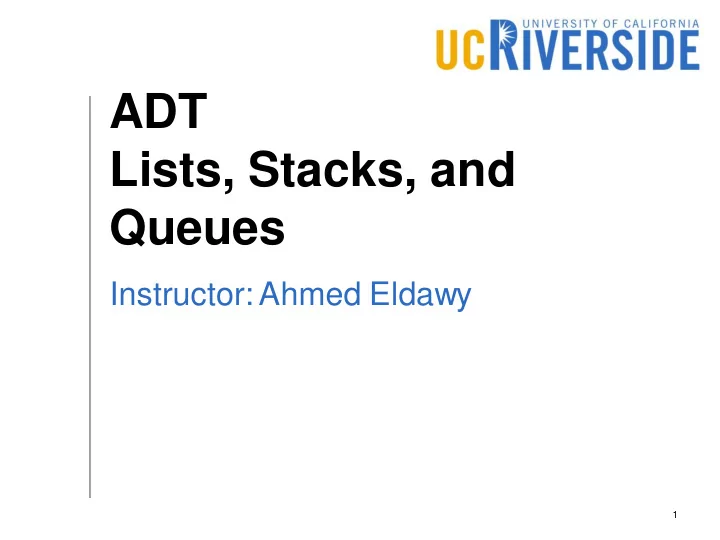

ADT Lists, Stacks, and Queues Instructor: Ahmed Eldawy 1
Objectives Understand the importance of ADT Learn how to implement ADT in C++ Recognize the difference between ADT definition and implementation Build an ADT for lists 2
Abstraction 3
Abstract Data Types Application Programs Operations ADT Physical Algorithm Memory Implementation Structure 4
Abstraction in C++ Application Programs Public methods Class Private member Private variables and methods constants 5
Example: Rational Numbers Application Programs Create, +, - , *, /, print, … Class Numerator GCD(x, y) Denominator Normalize() 6
ADT Design What is ADT design? Defining the public interface Who designs an ADT? You! With your users Sometimes, YOU are your own user 7
Lists List: A sequence of zero or more elements A 1 , A 2 , …, A N N: Size or length of the list A 1 : First element A N : Last element The order of items should be preserved 8
List ADT initialize(): Creates an empty list push_back(x): Appends the item x to the end of the list pop_back(): Removes the last element push_front(x): Prepends the item x at the beginning of the list pop_front(): Removes the first element insert(x, i): Inserts item x at position i erase(i): Deletes item at position i find(x): Finds the position of the element with value x size(): Returns the number of elements 9
Array Implementation of List List capacity C List size N A 1 A 2 … Consecutive memory space 10
Initialize List capacity C=10 List size N=0 initialize() { C=10 // Initial capacity N=0 // Initial size Allocate a memory space for C elements } 11
push_back(x) List capacity C List size N++ push_back(x) { A 1 if (N==C) the Expand A A 2 N = N + 1 … A N = x } A N x 12
push_front(x) List capacity C List size N++ push_front(x) { x if (N==C) the Expand A A 2 Shift all elements A 1 to A N A 3 by one position … A 1 = x A N N = N + 1 } 13
insert(i, x) List capacity C List size N++ insert(i, x) { A 1 if (N==C) the Expand A A 2 Shift all elements A i to A N by … one position A i = x x … N = N + 1 } A N 14
erase(i) List capacity C List size N-- erase(i) { A 1 Shift all elements A i+1 to A N A 2 by one position … N = N - 1 } A i … A N 15
pop_back() List capacity C List size N-- pop_back() { A 1 N = N - 1 A 2 } … A N 16
pop_front() List capacity C List size N-- pop_front() { A 1 Shift all elements A 1 to A N A 2 by one position … N = N - 1 } A N 17
Linked-list Implementation List size N T ail … A 1 A N Head Null 18
Initialize List size N=0 Null T ail Head Null initialize() { N=0 Tail = Head = Null } 19
push_back(x) push_back(x) { N=N+1 n = Allocate new node n.next = null n.value = x List size N++ if (Head is null) { Head = Tail = n } else { x T ail Tail.next = n Tail = n } Null } … A 1 A N Head 20
push_front(x) push_front(x) { N=N+1 n = Allocate new node n.next = Head n.value = x List size N++ if (Head is null) { Head = Tail = n } else { Head = n } T ail } … x A 1 A N Head Null 21
pop_front(x) pop_front(x) { if N=0 then raise exception N=N-1 old_node = Head Head = Head.next List size N-- delete old_node // Are we done? } T ail … A 1 A N Head Null 22
Array Vs Linked-list Operation Array Linked-list Initialize push_back push_front pop_back pop_front find erase clear 23
Array Vs Linked-list Operation Array Linked-list Initialize O(1) O(1) push_back O(1) O(1) push_front O(n) O(1) pop_back O(1) O(1) pop_front O(n) O(1) find O(n) O(n) erase O(n) O(n) clear O(1) O(n) 24
Recommend
More recommend